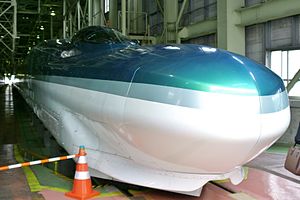Fastech 360
Fastech 360 is the name given to a pair of former experimental high-speed EMU trainsets developed by East Japan Railway Company (JR East) to test technology for the next-generation Shinkansen rolling stock. The name is a portmanteau of Fast, Technology, and 360 km/h (360 km/h or 225 mph), the target operational speed for production trains based on the new technologies. Speeds of up to 405 km/h (250 mph) were targeted during performance testing.[1] Results of testing using these trains was incorporated into the E5 series and E6 series trains, entering revenue service from 2011, eventually operating at 320 km/h (200 mph).
There were 2 trains:
- Class E954 Fastech 360S: 8-car set for use on shinkansen tracks only
- Class E955 Fastech 360Z: 6-car set for use on both shinkansen and Mini-shinkansen lines

Fastech 360 trains were equipped with emergency air braking plates like that of an aircraft, similar in appearance to the ears of a cat. This trait earned them a nickname of Nekomimi Shinkansen (猫耳新幹線), which literally means "cat-eared Shinkansen". This technology was not incorporated in the subsequent E5 series or E6 series trains.[citation needed]
Class E954 Fastech 360S
[edit]| Class E954 "Fastech 360S" | |
|---|---|
 The Fastech 360S train (stream-line end) at Omiya Station in May 2008 | |
| In service | 2005–2009 |
| Manufacturer | Hitachi, Kawasaki Heavy Industries |
| Constructed | 2005 |
| Scrapped | 2009 |
| Number built | 8 vehicles |
| Number in service | None |
| Number preserved | None |
| Number scrapped | 8 vehicles |
| Formation | 8 cars |
| Fleet numbers | S9 |
| Operators | JR East |
| Depots | Sendai |
| Lines served | Tohoku Shinkansen, Joetsu Shinkansen |
| Specifications | |
| Car body construction | Aluminium alloy |
| Maximum speed | 360 km/h (225 mph) (nominal) |
| Electric system(s) | 25 kV AC, 60 Hz Overhead catenary |
| Current collector(s) | Pantograph |
| Track gauge | 1,435 mm (4 ft 8+1⁄2 in) standard gauge |
This 8-car set (S9) was delivered on 26 June 2005. Cars 1 to 3 were built by Hitachi, and cars 4 to 8 were built by Kawasaki Heavy Industries.[2]
Car E954-1 has a stream-line profile, reminiscent of the 500 series, and E954-8 has an arrow-line profile more reminiscent of the JR East E2 series and E4 series designs.[3]
The train was withdrawn in September 2009 and scrapped.[4]
Formation
[edit]- E954-1 (T1c)
- E954-2 (M1) (with pantograph)
- E954-3 (M2) (with toilet)
- E954-4 (M2)
- E954-5 (M1s)
- E954-6 (M2)
- E954-7 (M1) (with pantograph)
- E954-8 (T2c)
-
The car 8 end in February 2009 with the arrow-line profile leading
-
E954-3 (car 3) in April 2006, with the green-coloured seats visible
Class E955 Fastech 360Z
[edit]| Class E955 "Fastech 360Z" | |
|---|---|
 The Fastech 360Z set S10 at Sendai Shinkansen Depot in July 2008 | |
| In service | 2006–2008 |
| Manufacturer | Hitachi, Kawasaki Heavy Industries |
| Constructed | 2006 |
| Scrapped | 2008 |
| Number built | 6 vehicles |
| Number in service | None |
| Number preserved | None |
| Number scrapped | 6 vehicles |
| Formation | 6 cars |
| Fleet numbers | S10 |
| Operators | JR East |
| Lines served | Tohoku Shinkansen, Akita Shinkansen |
| Specifications | |
| Car body construction | Aluminium alloy |
| Maximum speed | 360 km/h (225 mph) (nominal) 130 km/h (80 mph) (Akita Shinkansen) |
| Electric system(s) | 25/20 kV AC, 50 Hz Overhead catenary |
| Current collector(s) | Pantograph |
| Track gauge | 1,435 mm (4 ft 8+1⁄2 in) standard gauge |
This 6-car set (S10) was delivered on 6 April 2006. Cars 1 and 4 to 6 were built by Kawasaki Heavy Industries, and cars 2 and 3 were built by Hitachi[5] The train was withdrawn in December 2008 and scrapped.[2]
Formation
[edit]- E955-1 (M2c)
- E955-2 (M1s)
- E955-3 (M1) (with pantograph and toilet)
- E955-4 (M1)
- E955-5 (M1) (with pantograph)
- E955-6 (M2c)
References
[edit]- ^ "FASTECH 360 High-Speed Shinkansen Test Train to Debut". 9 March 2005. Retrieved 23 August 2009.
- ^ a b JR電車編成表 2009夏 [JR EMU Formations - Summer 2009]. Japan: JRR. June 2009. p. 13. ISBN 978-4-330-06909-8.
- ^ プロトタイプの世界 - Prototype World. Japan: Kōtsū Shimbunsha. December 2005. OCLC 170056962.
- ^ JR電車編成表 2010夏 [JR EMU Formations - Summer 2010]. Japan: JRR. May 2010. p. 13. ISBN 978-4-330-14310-1.
- ^ JR電車編成表 '07冬号 [JR EMU Formations - Winter 2007]. Japan: JRR. December 2006. p. 12. ISBN 4-88283-046-9.
External links
[edit]- Press release from JR East (in English)
- A bullet train... only with ears (BBC News)
- JR East press release: "新幹線高速試験電車 FASTECH 360 まもなくデビュー" (in Japanese)
- 新幹線高速試験電車E955形式 (FASTECH360Z)の概要 (in Japanese)
- Class E954 "Fastech 360 S" (Japan Railfan Magazine Online) (in Japanese)
- Class E955 "Fastech 360 Z" (Japan Railfan Magazine Online) (in Japanese)













